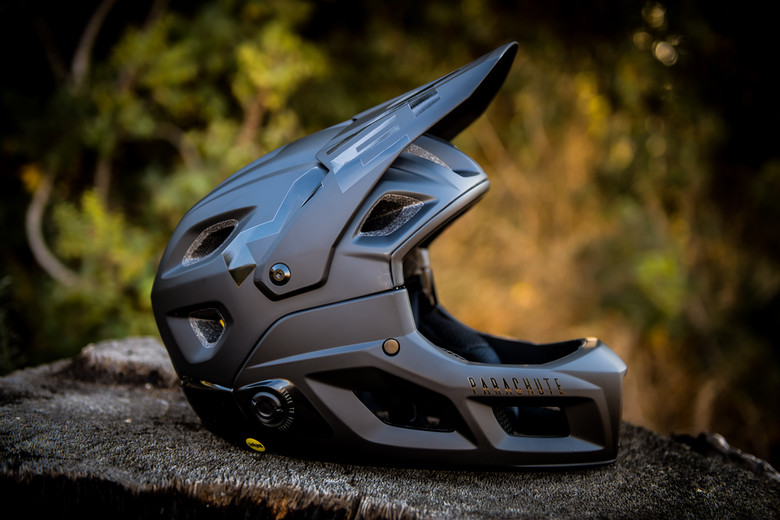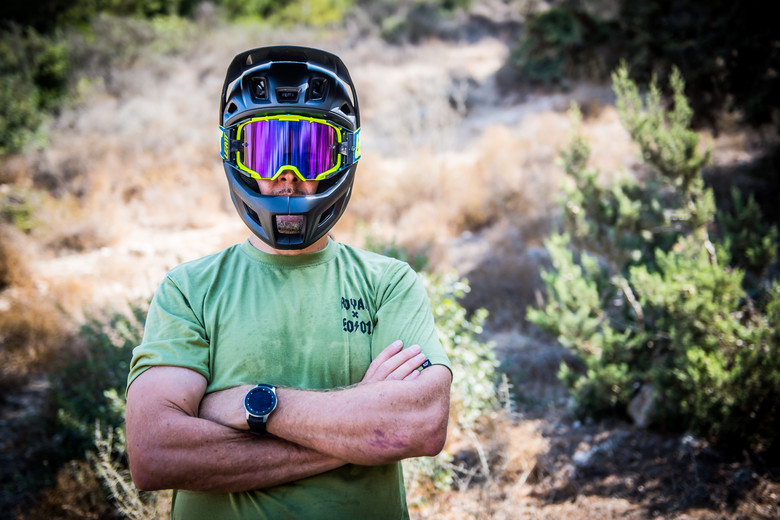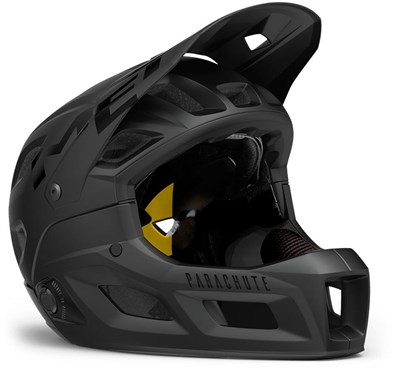MET Parachute MCR Full Face Helmet
| Where To Buy | |||
|---|---|---|---|
Free Delivery on purchases over £20.
|
Free Delivery on purchases over £20.
£239.99
|
||
Free shipping on orders over $50 (continental U.S. only).
International shipping available. Some exclusions apply. |
Free shipping on orders over $50 (continental U.S. only).
International shipping available. Some exclusions apply. $380.00
|
||
Free shipping on orders over $50 (continental U.S. only).
International shipping available. Some exclusions apply. |
|||

Dating back to the original Parachute, MET has been at the forefront of the lightweight, breathable full face helmet game for a long time. While that first Parachute was certainly polarizing in terms of its looks (and the skimpy nature of its chin bar), it paved the way for a slew of successors as more and more companies realized the advantages of extra protection in a helmet that can be worn on a trail ride. The second generation of the Parachute was a big step forward both in terms of design and safety certification (as it met the requirements of the DH-specific ASTM F1952 standard), with just a few smaller issues holding it back a little when we tested it against its main competitors earlier this year. Enter the Parachute MCR, the third generation of the Parachute. “MCR” stands for “Magnetic Chinbar Release”, which tells us that this helmet now features a removable chinbar. Curious to see what it would all add up to out on the trails, we’ve tested one and now we’re here to tell you all about it.
Strengths | Weaknesses |
|
|
MET Parachute MCR Highlights
- 21 vents
- Flexible visor, adjustable for goggle storage
- 2 sets of cheekpads included to fine tune fit
- BOA 360 internal adjustable harness
- MIPS-C2
- EPS liner
- “MCR” = “Magnetic Chinbar Release” system developed with Fidlock
- Fidlock chin strap buckle
- ASTM F1952-15 / F2032-15 certified
- Weight: 871 grams full face mode / 497 grams half shell mode (size L, verified)
- 6 colors
- Sizes: S (52-56) / M (56-58) / L (58-61)
- MSRP: EUR 330
Initial Impressions
They say third time’s a charm, and that certainly proved true when it comes to the design of the Parachute. Now in its third iteration, the styling has finally reached a point where most people will probably find it relatively good looking at a minimum. Available in six different colors, the lines of the MCR are aggressive and purposeful, particularly in full face mode. Gone are the ugly duckling proportions that plagued its predecessors.



Convertible full face helmets are commonplace by now, but the MCR has a trick up its sleeve: the “Magnetic Chinbar Release” system that was co-developed with Fidlock (the company behind the ever more popular magnetic chin strap buckle). The system features two metal hooks and two magnetic locks that snap into place and release with a twist of a knob. Intended to make it easy to remove and attach the chin bar while wearing the helmet, the system also provides a design advantage: it is unobtrusive and does not take up much space.




Looking beyond the innovative chin bar release system, the feature list of the Parachute MCR is long. BOA 360 adjustable harness, MIPS, Fidlock chin strap buckle, two sets of cheek pads, flexible/adjustable visor, and of course all the relevant safety certifications including the DH-specific ASTM standard. A note on standards: they specify a minimum amount of energy that a helmet should be able to absorb, as well as certain other safety aspects. The ASTM F1952-15 / F2032-15 standards are more stringent than “regular” bike helmet standards, and they include requirements that a chin bar must meet if one is present. The fact that a helmet like the Parachute MCR meets all these standards is reassuring enough, but you should still think long and hard about how you will use a helmet before committing to a particular design. It is highly likely that a full-fledged DH helmet will ultimately offer better protection than some of these newer, more breathable options, but there is no standard available to actually measure what the difference is. Once the ASTM standard is met, that’s that.




On The Trail
The Parachute MCR is available in three shell sizes. With a head circumference of 58cm, this tester is usually right between an M and an L in most helmets. We opted for the L in this case, which is indicated for head sizes from 58cm to 61cm. We found it generously sized, to the point that this tester could also have easily fit into the M. With the thicker of two supplied cheek pads installed and the BOA cranked tight, the fit was good and the helmet was stable in use. The overall level of comfort is high, with no obvious pressure points or other issues getting in the way of a good experience. The internal padding is thinner than most “regular” full face helmets, and as such the fit and feel is more airy. Open space around the ears also lets you hear what is going outside the helmet, as opposed to many regular full face helmets.


On the trail, we started our testing in full face mode. In action, the Parachute MCR is very stable, thanks in part to its relatively low weight but more importantly good weight distribution. Even without cranking the BOA down like crazy, we found that the helmet would more or less remain in place, particularly if used with a pair of goggles. On that topic, the frontal opening is large and will easily accommodate your goggle of choice. The large visor sits in the right spot, providing protection from the sun but not getting in the way of your vision. The ability to quickly push the visor back to provide goggle storage space is a definite plus. In terms of breathability, the vents and air channels do a good job of moving air through the helmet as soon as you are rolling. The chin bar is slightly less open than some of the other helmets in this category and it sits relatively close to your mouth, which can sometimes cause your expelled breathe to bounce back in your face (this will depend on individual fit and head shape). Overall the ventilation is good and we were able to use the Parachute MCR on very hot days even without removing the chin bar.

Popping the chin bar off is as easy as advertised, just turn the two knobs and the MCR system releases, then pull the chin bar towards the front and it slides away. The knobs are quite small which makes them harder to manipulate with gloves, but overall, the release phase of the operation is simple to master. In open face mode, we found the Parachute MCR slightly less stable, as it seemed to end up riding a little bit looser on the head (this will obviously depend on the user’s head shape). No doubt a size M would have created an overall tighter fit for this tester which could have been ideal in open face mode.




Putting the chin bar back on is more involved. The system is easy enough to line up, but we found the MCR mechanism reluctant to engage, particularly when the helmet was new. Do one side at a time and you’ll soon get the hang of it, but we think that the performance of this aspect of the system could be polished up a bit. And that brings us to our final observation on the concept: with the lightweight full face options currently available on the market, we find that the convertible helmets offer more inconvenience than advantage. Yes it can be practical to be able to buy two helmets in one, especially if you travel a lot or if you only occasionally need the extra coverage, but with the kind of riding we all seem to be doing more of these days, a full face helmet should really be considered almost mandatory for most of it anyway. Modern trail bikes are so capable that even when you earn your turns, you end up hauling the mail on the way back down, and we don’t see enough benefit to being able to remove the chin bar to warrant the extra weight and expense. We’d rather go with a dedicated lightweight full face option instead of having to fiddle with removing and putting back a chin bar (not to mention finding a place to store it for the climb), but for those who are seduced by the two-in-one concept, the Parachute MCR is definitely one of very best available right now.
Things That Could Be Improved
Overall, we were very impressed with the features and the quality of the Parachute MCR. The MCR mechanism is slightly awkward to put back together, we’d like to see MET improve the slickness of the action here. The chin bar also doesn’t breathe as well as certain competitors, due to its shape and position.
Long Term Durability
This is just a First Ride type of review, so we cannot offer any definitive observations on longevity. As mentioned previously, the quality and workmanship are of high level, so we would expect a good few seasons of use out of the Parachute MCR, barring any major crashes that would compress the EPS liner (at which point any helmet of this design should be immediately discarded).
What’s The Bottom Line?
With higher speeds, more technical trails and more capable bikes comes increased risk, and many riders find themselves looking for more protection than a classic half shell helmet even for regular “trail rides”. A number of lightweight, breathable full face options are now available to answer to this need, and MET has just thrown its latest hat in the ring with the all-new Parachute MCR. Sporting a clever magnetic release system on the removable chin bar, this ASTM-certified helmet is loaded with both safety and comfort features. Stable and well ventilated in use, it provides an interesting option for those riders who are reluctant to splurge on a full-fledged DH helmet but want the option of full coverage when the conditions dictate it. We’re still of the opinion that some of the non-convertible options in the lightweight, breathable full face category offer all the advantages with almost no drawbacks, but for those who are onboard with the two-in-one concept the Parachute MCR is definitely one of the top choices today.
More information at: www.met-helmets.com.
About The Reviewer
Johan Hjord - Age: 46 // Years Riding MTB: 14 // Weight: 190-pounds (87-kg) // Height: 6'0" (1.84m)
Johan loves bikes, which strangely doesn’t make him any better at riding them. After many years spent practicing falling off cliffs with his snowboard, he took up mountain biking in 2005. Ever since, he’s mostly been riding bikes with too much suspension travel to cover up his many flaws as a rider. His 200-pound body weight coupled with unique skill for poor line choice and clumsy landings make him an expert on durability - if parts survive Johan, they’re pretty much okay for anybody. Johan rides flat pedals with a riding style that he describes as "none" (when in actuality he rips!). Having found most trail features to be not to his liking, Johan uses much of his spare time building his own. Johan’s other accomplishments include surviving this far and helping keep the Vital Media Machine’s stoke dial firmly on 11.
Photos by Nils Hjord and Johan Hjord
Specifications
Shock absorbing polystyrene inner shell
PU-injected lining chinbar with MCR Magnetic release
Embedded strap anchors
Flexible injected and adjustable visor
CE EN 1078:2012
US CPSC 1203
AS/NZS 2063:2008
MIPS liner
Extended head coverage
FIDLOCK magnetic chin strap buckle
| Where To Buy | |||
|---|---|---|---|
Free Delivery on purchases over £20.
|
Free Delivery on purchases over £20.
£239.99
|
||
Free shipping on orders over $50 (continental U.S. only).
International shipping available. Some exclusions apply. |
Free shipping on orders over $50 (continental U.S. only).
International shipping available. Some exclusions apply. $380.00
|
||
Free shipping on orders over $50 (continental U.S. only).
International shipping available. Some exclusions apply. |
|||

























































10 comments
Post a reply to: First Ride: MET Parachute MCR Convertible Full Face Helmet